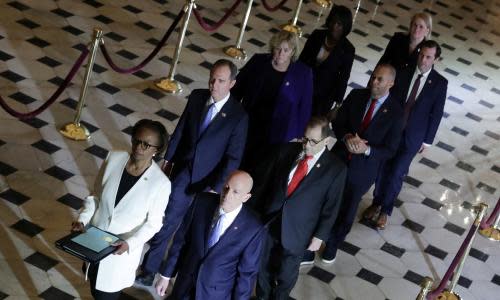Trump impeachment: solemn march across Capitol marks historic moment

After a day of routine commotion on Capitol Hill, the hallways quieted and attention turned to the slips of paper inside a pair of blue folders bound for the Senate.
A procession of newly appointed impeachment managers solemnly accompanied the articles of impeachment across the Capitol in a ritual performed only twice before in the nation’s 232-year history.
Journalists and onlookers strained to capture every historic step of the highly choreographed proceedings. Every clack of a heel against the marbled floors of the Capitol inspired another flurry of photos.
The ceremonial handoff from the chamber that brought the charges to the chamber that will prosecute them felt anachronistic in the age of emails, texts and tweets. But it added a sense of formality and historical heft, nearly one month after the House impeached Trump on charges of abuse of power and obstruction of Congress.
Related: Who are the impeachment managers at Trump's Senate trial?
The House clerk, Cheryl Johnson, carried the articles, flanked by the sergeant-at-arms, Paul Irving. They led the march through Statuary Hall, where luminaries from the 50 states are honored, then under the vaulted dome of the rotunda that divides the Capitol and past the Ohio Clock, a looming mahogany timepiece that announces the entrance to the Senate’s stately chamber.
Their cadence hardly slowed as they proceeded through the doors of the Senate, literally crossing what Pelosi has symbolically described earlier as a “very important threshold in American history”. Impeachment was now in the Senate’s hand.
The procession was met by Laura Dove, secretary for the Republicans, who gestured for the managers to gather in a corner of the chamber. They stood silently, their hands clasped, while more than two dozen Democrats watched from their desks on the Senate floor.
“Mr President, a message from the House of Representatives,” Dove declared. Johnson read aloud the resolution adopting the two articles and appointing the seven managers.
A Senate official retrieved the articles from the House clerk and delivered them to Senator Chuck Grassley, the Senate’s president pro tempore who presided over the chamber from the wooden rostrum.
The Senate majority leader, Mitch McConnell, rose to acknowledge the message and offer a series of resolutions that would shape the ensuing trial.
On Thursday, John Roberts, the chief justice of the US supreme court, who will preside over the trial, will be sworn in by Grassley. Roberts will then administer the same oath, to do “impartial justice according to the constitution and laws” to each of the chamber’s 100 senators, who will serve as a jury.
The House’s case for removing the president will be presented by a team of seven Democrats, who, for the first time in history, will look less like the nation’s all-white, all-male Founding Fathers and more like the rest of the country. Three of the seven managers are women, two are African American and one is Hispanic.
The lineup includes a former federal prosecutor, a former police chief, an army ranger and the only member of Congress to participate in all three modern impeachments.
The transmission ended a four-week standoff between a self-described “master legislator” and the self-described “grim reaper”. The House speaker, Nancy Pelosi, and McConnell had been at odds after her unprecedented decision to delay sending the articles to the Republican-held Senate.
In the House, the intermission between Trump’s impeachment and the delivery of the articles had only hardened the partisan rancor that has gripped the process.
At midday the chamber convened to debate impeachment one last time on the House floor before approving, in a 228 to 193 vote that fell almost entirely along party lines, a resolution that would transmit the articles to the Senate and appoint the managers, who will function as prosecutors in the trial.
“My colleagues in the minority would rather talk about anything than try to defend what President Trump actually did because they can’t,” congressman Jerry Nadler, the chair of the judiciary committee and an impeachment manager, said, his voice rising with indignation.
The House Republican leader, Kevin McCarthy, decried the process as the “fastest, thinnest and weakest impeachment in American history”, finding consolation in the belief that a Senate trial would finally bring to an end to what he called a “sad saga” and a “national nightmare”. He accused Pelosi of hypocrisy for withholding the articles after arguing that Trump posed such a serious threat to the rule of law that Congress could not wait to act until the presidential election in November 2020.
“Don’t talk to me about my timing,” Pelosi shot back in a speech moments later. “For a long time, I resisted the calls from across the country for impeachment of the president … Frankly, I said this president isn’t worth it. But when he acted the way he did in [relation] to withholding funds from Ukraine in return for a benefit to him that was personal and political, he crossed the threshold. He gave us no choice.”
That afternoon, Pelosi, flanked by her impeachment managers and the committee chairman and under the gaze of a portrait of the nation’s first president, signed both articles of impeachment.
Moments later, at 5.34pm, the managers officially handed over the articles, concluding their effective death march to the Senate, where McConnell has said “only one outcome” is suited to what he called a “constitutionally incoherent” case brought against the president in a “fit of partisan rage”.
But there is still plenty of scope for a courtroom drama and unexpected plot twists in the coming days and weeks. On Tuesday the House handed over a trove of revealing new documents pertaining to Trump’s pressure campaign against Ukraine, and the managers signaled on Wednesday that more was to come.
Whatever verdict awaits the president in the Senate, Pelosi believes the House has fulfilled its duty.
“He has been impeached forever,” she said. “They can never erase that.”
